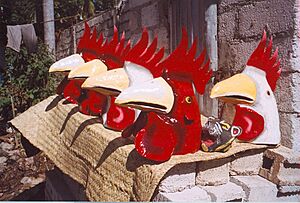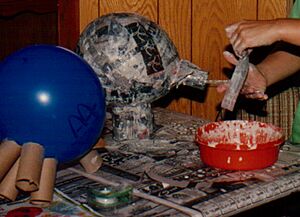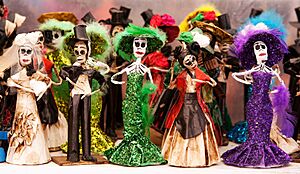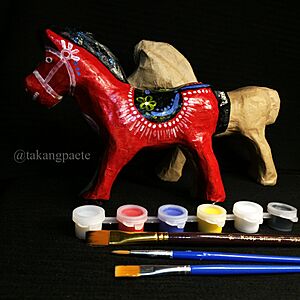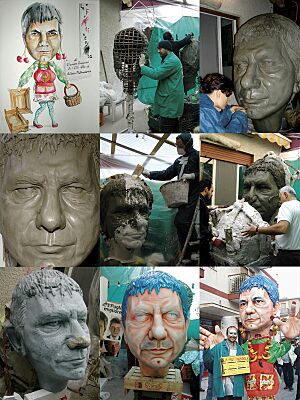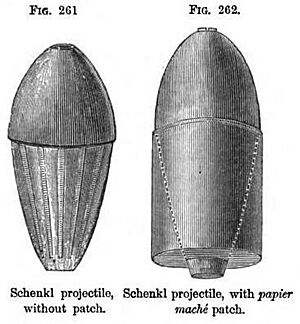Papier-mâché facts for kids
Papier-mâché (pronounced PAP-ee-ay MASH-ay or PAY-per muh-SHAY) means "chewed paper." It's a cool material made from pieces of paper or paper pulp mixed with glue. Sometimes, people add fabric to make it even stronger. Common glues include regular craft glue, starch, or wallpaper paste.
Papier-mâché is often used because it's cheap and easy to work with. People use it for traditional art, ceremonies, and fun crafts. It's a popular hobby for many to create decorative items.
Contents
How to Make Papier-mâché
There are two main ways to make papier-mâché:
- Paper Strips Method: You glue strips of paper onto a shape.
- Paper Pulp Method: You turn paper into a soft pulp, then mix it with glue.
For the paper strips method, you need a base shape, like a balloon or a wire frame. You dip paper strips into glue and layer them onto this shape. For the pulp method, you can mold the paper pulp directly into the shape you want. Sometimes, you might add wire or chicken wire inside for extra strength.
Making the Glue
The simplest glue is a mix of water and flour, like a thick cream. You can also use craft glues like PVA glue. To stop mold from growing, especially if you live in a humid place, you can add a little salt or oil of cloves to your glue mix. Another good option is methyl cellulose, which is non-toxic and naturally mold-free.
Using the Paper Strips Method
First, cut or tear paper into strips. Soak these strips in your glue until they are fully wet. Then, place the wet strips onto your chosen shape, overlapping them. Let it dry slowly. If you're making a cast of an object, you might put a little oil or grease on the object first so the papier-mâché doesn't stick. Once completely dry, you can cut, sand, or paint your creation. To make it waterproof, paint it with a special water-repelling paint. Make sure the glue is totally dry before painting, or mold could grow inside!
Using the Paper Pulp Method
For this method, soak paper in water overnight, or boil it until it breaks down into a soft pulp. Drain out the extra water, then mix in your glue. Now you can press the pulp onto a form or sculpt it by hand, especially for smaller items.
History of Papier-mâché
Ancient Origins
People in China were probably the first to use papier-mâché around 200 CE, not long after they learned how to make paper. They used it for things like helmets for warriors, cases for mirrors, and masks for ceremonies.
In ancient Egypt, people made coffins and death masks from layers of papyrus or linen covered with plaster. This was a bit like papier-mâché.
Across Asia
In places like Persia, Japan, and China, papier-mâché was used to make beautiful small boxes, trays, and cases. In Japan and India, it even helped decorate armor and shields.
Kashmir's Special Papier-mâché
The art of papier-mâché came to Kashmir in the 14th century. Craftsmen from Iran brought the technique, using handmade paper pulp. Today, Kashmir papier-mâché is famous for making all sorts of items like boxes, bowls, vases, and decorative animals. It's a luxury handicraft and is protected by Indian law as a special traditional product.
Papier-mâché in Europe
Papier-mâché arrived in Europe in the 15th century. At first, it was used to make religious figures and decorations for churches.
Italy's Creations
In Italy, papier-mâché became popular for making copies of famous statues, especially religious ones. This allowed more people to have these figures. By the 18th century, the city of Lecce in southern Italy became very well known for its papier-mâché art, and it still is today!
Other European Uses
In the 16th century, papier-mâché was used in Germany to make many copies of images, like portraits of Martin Luther.
Around 1725, people in Europe started using gilded (gold-covered) papier-mâché as a cheaper way to decorate buildings instead of using carved wood or plaster. In 1772, Henry Clay in England found a way to make waterproof papier-mâché panels by treating paper with linseed oil. These were used for things like coach doors. Later, a process was invented to press these sheets into different shapes for trays and chair backs. Russia also had a big industry making beautiful painted papier-mâché items.
Mexican Cartonería
In Mexico, papier-mâché sculpture is a traditional craft called "cartonería." These sculptures are very stiff, like "rock cardboard." They are often made for special yearly events, like the Burning of Judas during Holy Week or decorations for Day of the Dead. Other items include piñatas, masks, and dolls. Papier-mâché came to Mexico during the time of Spanish rule and has grown into a unique art form, especially in central Mexico.
Philippine Taka
In the Philippines, papier-mâché is called "taka." It's a famous folk art from the town of Paete. The first known taka was made by wrapping paper around a carved wooden mold and then painting it.
Cool Old Uses of Paper
In the 19th century, people in America even made paper canoes! The paper was very stretchy when wet, which was perfect for making a smooth boat hull. Layers of dampened paper and glue were put over a mold, dried, and then waterproofed. These paper boats were very fast in races.
Papier-mâché was also used to make lightweight domes for observatories in the late 1800s and early 1900s. These domes needed to be light so they could easily turn to point telescopes in any direction.
Modern Uses of Papier-mâché
Today, with modern plastics and other materials, papier-mâché isn't used as much in big industries. But it's still super popular for arts and crafts because it's easy to make and costs very little.
Carnival Floats
Papier-mâché is perfect for making huge, temporary sculptures like Carnival floats. A basic frame of wood and wire mesh (like chicken wire) is covered with papier-mâché. Once dry, artists add details, sand, and paint it. Carnival floats can be enormous, with many characters and moving parts. They often involve professional artists and engineers!
Costumes and Theatre
Making papier-mâché masks is a fun activity for kids and craft lovers. You can use your own face or a balloon as a mold. Masks are popular for Halloween and other dress-up events.
Papier-mâché is also a cheap material for making props and sets for plays and puppet shows. The famous Bread and Puppet Theater company used it a lot for their puppets.
Military Uses of Papier-mâché
Paper Sabots
Believe it or not, papier-mâché was used in some firearms! It was made into "sabots," which are parts that help push a bullet out of a gun barrel. Even with the high heat and pressure, papier-mâché was strong enough to work well in both small guns and large artillery.
Drop Tanks
During World War II, some airplanes used fuel tanks made from plastic-treated paper. These tanks were attached to the plane to give it extra fuel for longer flights. When the fuel was used up, the tanks could be dropped off the plane, allowing fighter planes to fly alongside bombers on long missions.
Combat Decoys
In World War I, the British used papier-mâché figures that looked like soldiers to trick enemy snipers. Some even had cigarettes that smoked! When a sniper shot at the decoy, the bullet hole showed where the sniper was hiding, helping soldiers find them.
Gallery
-
Carmen y los superhéroes de la Naturaleza, a Catrina exhibited at the Interactive Museum-Labyrinth of Science and Arts in San Luis Potosí City (San Luis Potosí, Mexico)
-
Chair decorated with papier-mâché and mother of pearl, exhibited in the Museum of Carmen de Maipú (Chile)
See also
- Russian lacquer art
- Decoupage
- Japanning
- Wet-folding, an origami technique that uses damp paper.


